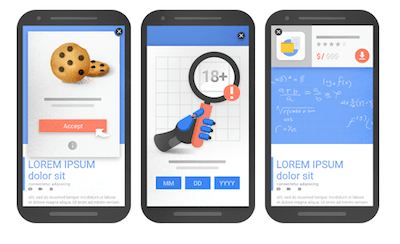Written by María Navarro
Index
Google will start penalizing websites that use pop-ups and interstitial ads that prevent the display of web content as of January 10, 2017.
In order to explain this penalty and its peculiarities, I would first like to comment briefly on what pop-ups and interstitial ads are.
What are pop-ups?
Pop-ups are pop-up windows that usually appear automatically (usually without the user’s request). In general, pop-up windows are used for intrusive advertising, although they are also used as a means of attraction.
Some examples of the use of pop ups are:
- Subscribe to a newsletter.
- Display legal notices such as the cookie notice.
- Access to private user areas.
What are interstitial ads?
Interstitial is the advertising format that appears on a website before viewing its content, occupying the entire screen for a few seconds or until the user proceeds to close it.
Both pop-ups and interstitial ads are often considered annoying by most users, since while browsing a website, they feel that they are being bombarded by pop-ups that seem to be trying to scare them by popping up when they least expect it. In addition to being annoying, they prevent the correct display of the information that the user is looking for on the website. This problem is aggravated on mobile devices mainly because of the screen size.
The biggest problem with pop-up windows is that the person who decides to include them in his website does not make the appropriate configuration so that they do not cause an intrusive or massive effect on the user , but is usually governed by advertising and business principles.
Why is Google going to implement this penalty in its algorithms?
The mobile device is currently the most widely used for Internet browsing and is an increasingly consolidated trend. Therefore, for some years now, one of Google’s objectives has been to improve the user experience on these devices.
It began by implementing measures to improve the user experience on mobile devices with penalizing those websites that were not adapted to mobile devices. An attempt was made to achieve this through the tags “mobile-friendly” that websites were fully usable on mobile devices without the need for zooming or side-scrolling.
Even today, there are still many websites that are not optimized for mobile devices and even worse, new sites are still being developed without such optimization.
If you still have doubts about whether your site is optimized for mobile devices, you can check it with Google’s validator tool.
To continue with its goal of improving the experience on mobile devices, Google has announced that as of January 10, 2017, it will begin to penalize all those websites that use “pop-ups” or interstitial ads in mobile version.
It should be noted that just because only the mobile version is affected, it is not a major penalty and therefore should not be ignored, since, as I mentioned earlier, Internet connections via mobile devices exceed those made by computer and this is a growing trend.
Google’s goal is to make it easy for users to locate the information they need as quickly as possible and with the best quality.
So how does this penalty really affect my website?
Google has detected that a large percentage of websites in their mobile version abuse intrusive pop-ups. This generates a bad user experience that hinders the visualization of the content they are really looking for. This is why he has declared that he will take action in this regard.
Why do you focus only on mobile devices?
Because the screens of such devices are much smaller than a computer, so the pop-up window occupies a higher percentage of display and is therefore more annoying than on desktops or tablets.
Do you penalize all types of pop-up windows?
The answer is no. It is important to note that Google will not penalize all types of pop-up windows, but only those that do not meet the characteristics they propose, focusing mainly on the fact that, as mentioned above, they should not be too intrusive.
It doesn’t matter whether the pop-up window is executed once we land on the page, before even viewing its content or after scrolling and browsing through it. O toven if it has a nice and visible “x” to close. Whenever it is intrusive it will penalize.
Example of pop-up windows that will penalize:
What type of pop-up window does not penalize?
As we have mentioned, not all pop-up windows on cell phones are penalized, there are a number of features that allow us to continue using them:
- The pop-up window is used to display legal information, such as a cookie notice or verification of age of majority to access the site.
- The pop-up window is used for user access where the content is not indexable.
- The pop-up window is used for partial advertisements that take up a reasonable percentage of screen space and are easy for the user to close.
Example of pop-up windows that will NOT be penalized:








